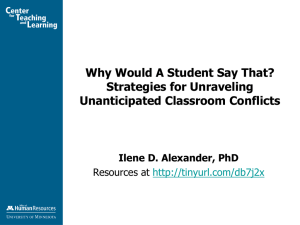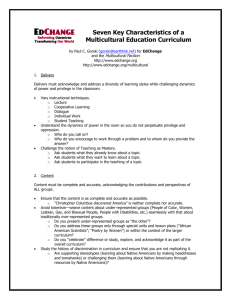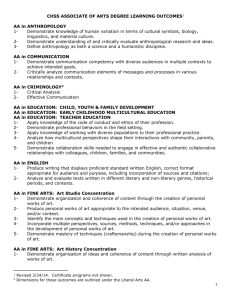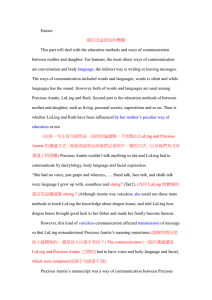Midterm Essays - Liberal and Critical Muliculturalism Perspectives
advertisement
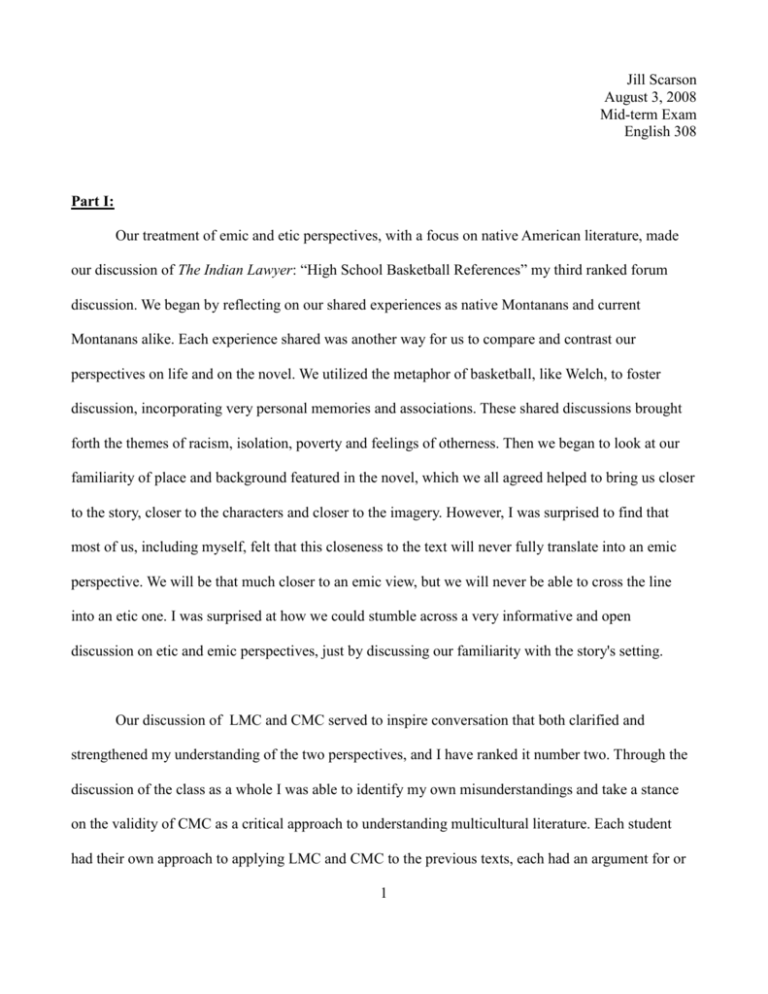
Jill Scarson August 3, 2008 Mid-term Exam English 308 Part I: Our treatment of emic and etic perspectives, with a focus on native American literature, made our discussion of The Indian Lawyer: “High School Basketball References” my third ranked forum discussion. We began by reflecting on our shared experiences as native Montanans and current Montanans alike. Each experience shared was another way for us to compare and contrast our perspectives on life and on the novel. We utilized the metaphor of basketball, like Welch, to foster discussion, incorporating very personal memories and associations. These shared discussions brought forth the themes of racism, isolation, poverty and feelings of otherness. Then we began to look at our familiarity of place and background featured in the novel, which we all agreed helped to bring us closer to the story, closer to the characters and closer to the imagery. However, I was surprised to find that most of us, including myself, felt that this closeness to the text will never fully translate into an emic perspective. We will be that much closer to an emic view, but we will never be able to cross the line into an etic one. I was surprised at how we could stumble across a very informative and open discussion on etic and emic perspectives, just by discussing our familiarity with the story's setting. Our discussion of LMC and CMC served to inspire conversation that both clarified and strengthened my understanding of the two perspectives, and I have ranked it number two. Through the discussion of the class as a whole I was able to identify my own misunderstandings and take a stance on the validity of CMC as a critical approach to understanding multicultural literature. Each student had their own approach to applying LMC and CMC to the previous texts, each had an argument for or 1 against both perspectives. Each question and answer urged me to think more deeply and abstractly about the subject and to accept or reject many of the thoughts expressed by my peers. “I think, therefore I am,” says Descartes and if he's right, I am a much more learned, much broader person for having participated in this forum discussion. While I learned a lot about emic and etic perspectives and LMC versus CMC perspectives in the previous forum discussions, I truly enjoyed our forum discussion The Bonesetter's Daughter Part I: “Communication.” Perhaps it is because it was our first forum discussion, or because I had been dying to see what other people had to say about this fantastic book, or due to my embarrassing excitement of my very first online class. I'm sure it is a combination of all of the above, but I also love that we as a community could get together, without ever meeting in real life, to read and engage one another in conversation on diverse and universal topics. Communication between cultures, genders, and generations is explored in an atmosphere where communication is the primary goal and expectation of the entire community. The wealth of ideas, themes, and issues approached and interrogated were enlightening, enabling, and encouraging to me as a student and as a dedicated reader. It was just the right foot to start off on, in this journey of exploration and learning, by way of communication. Part II: The literary technique of magical realism is intentionally utilized in Alvarez's How the Garcia Girls Lost Their Accents to represent the girls' struggle to assimilate in American culture while keeping their Dominican identities. Yolanda's character uses magical realism to describe her feelings of displacement, both from her native culture and from her own mind. She begins to have flashbacks, which are characteristic of magical realism, where time is predominately circular and sometimes negligible. “She recognizes the unmistakable signs of a flashback: a woman at a window, a woman 2 with a past, with memory and desire and wreckage in her heart. She will let herself have them today. She can't help herself anyway”(page 69). Is she Yolanda, Yo, Yo-Yo, or Joe? Each name has a cultural prerogative associated with it, each has its own cultural demands. They are a multiplicity of identities associated with just one confused Yolanda. Yolanda's, or Joe's rejection of her traditional values is manifesting itself in her identity crisis. Her “personality phenomenon” is represented through magical realism and the use of authorial reticence to place the reader in a reciprocal state of identity confusion. Is it “the real Yolanda resurrecting...”(page 83)? “She tries to laugh, but instead of laughter, she feels ticklish wings unfolding like a fan at the base of the throat. They spread her mouth open as if she were screaming a name out over a great distance. A huge black bird springs out; it perches on her bureau, looking just like the raven in Yo's first English poetry book...Out it flies, delighting in its new-found freedom...”(page 83-4). This break from reality is, as Carla believes, “a borderline schizoid response to traumatic cultural displacement”(page 117). Her cultural confusion and identity struggle, represented by Alvarez's use of magical realism, serves to bridge the gap between Dominican and American cultures. We have all felt “other” and struggled with issues of identity and displacement. By placing the reader in similar confusion and disjunction through the use of magical realism, Alvarez is able to impart a truer and deeper understanding of what it is to struggle against yourself, in culture and identity. Lahiri's short story collection, The Interpreter of Maladies, uses the juxtaposition of many different perspectives to portray cultural connections and conflicts in both Indian and American culture. In A Temporary Matter, marital relationships and gender issues are intimately explored. It isn't until the lights are turned off on Shoba and Shukumar's life that they truly begin to see each other in reality. 3 “Something happened when the house was dark. They were able to talk to each other again...Somehow without saying anything, it had turned into this. Into an exchange of confessions-the little ways they'd hurt or disappointed each other, and themselves... They wept together, for the things they now knew ”(page18-19,22). Their different gender perspectives are explored by way of Lahiri's use of first-person narratives, in which the reader is allowed great intimacy and access to the thoughts and emotions of both Shoba and Shukumar. The cultural conflict between Indian and Pakistani, Muslim and Hindu, and the connection that this very conflict creates is explored in When Mr. Pirzada Came to Dine. Lahiri uses the child's point of view to objectively examine the relationship between her Indian Hindu parents and their friend, a Pakistani Muslim. “'Mr. Pirzada is no longer considered Indian,' my father announced... He told me that during Partition Hindus and Muslims had set fire to each other's homes. For many, the idea of eating in the other's company was still unthinkable...It made no sense to me”(page 25). Mr. Pirzada was Indian once, and this reality is not lost on Lilia. She recognizes that he is like her parents, they observe the same eating habits and social practices and even speak the same language. The true connection between these people comes from the inhumanity of the social and political situation. During a time of cultural conflict, two different, yet similar, cultures can make a connection based on understanding and acceptance. In Mrs. Sen's, Lahiri uses the contrasting perspectives of an American child and an Indian woman to explore the issues of isolation and cultural displacement. “Here, in this place where Mr. Sen has brought me, I cannot sometimes sleep for so much silence...Everyone, this people, too much in their world... 'Send pictures,' 4 they write. 'Send pictures of your new life.' What pictures can I send?...They think I live the life of a queen, Eliot”(pages 115, 121, 125). The reader gets a clear view, through Eliot's eyes, of the fear and sadness that an immigrant, of any culture, must feel when placed into a new world. In The Bonesetter's Daughter, written communication is designed to be an essential theme throughout the narrative. For Ruth and LuLing, the written word both complicates and facilitates their communication with each other. Ruth, as a ghost writer, communicates other's feelings by means of the written word. Yet she can never envision herself writing her own story. LuLing's English forces Ruth to translate for her mother as a small child, which causes Ruth to resent her mother's cultural differences. In this way, she is allowed to interpret her mother's words in any way she likes, confusing LuLing's true meaning with her own insecurities. During the most tumultuous part of their relationship, Ruth loses the ability to speak. To facilitate her speech, Ruth begins to draw in sand. She ghost writes as Precious Auntie, as a way to communicate with LuLing. As an adult, Ruth is again forced to translate her mother's words. From those words, she finds out who her mother is and in turn who she is. She discovers her grandmother's name, Gu, and in turn her character. She also discovers something about herself, along with her family's language. “Ruth had once thought that Chinese was limited in its sounds and thus confusing. It seemed to her now that its multiple meanings made it very rich...She realized that Mr. Tang translated for LuLing, as she once had. But he knew not to be concerned with words and their precise meanings. He simply translated what was in LuLing's heart: her better intentions, her hopes”(pages 391, 398). Ruth learns that the written word, in English or Chinese, can both facilitate and complicate communication. 5 Part III: Throughout the canons of multicultural literature, similar issues and conflicts appear across cultural boundaries. When studied through the perspective of liberal multiculturalism and critical multiculturalism, texts, characters, themes, and situations can be both universal and particular to a specific culture. By exploring different cultural perspectives, in this case, Chinese, Dominican, Indian, and native American, and applying critical analysis to the work, the reader can understand their intersections and appreciate their differences. Liberal multiculturalism is the analysis of different cultures, “for the purpose of engendering respect for and appreciation of difference and diversity...and emphasizing commonality in/above difference”(“Theoretical Positions”). This devotion to commonality allows texts, characters, themes and situations to be universal across diverse backgrounds in multicultural literature. An etic understanding of multicultural literature also creates a sense of universality by allowing the reader to make assumptions about another culture (“Emic and Etic Perspectives”). Liberal multiculturalism rejects an “us versus them” approach to multicultural literature and embraces a “we're all the same” association (“Whiteness Studies”). Universal themes, such as communication and identity, and their representation of a broader humanity, are valued over individual differences. Examples of this universality in multicultural literature can be found by comparing different texts by different ethnic groups. In the Bonesetter's Daughter, communication is a dominate theme that runs throughout the novel. As a child, LuLing is forced to translate for Precious Auntie. LuLing writes, “She had no voice, just gasps and wheezes, the snorts of a ragged wind. She told me things with grimaces and groans, dancing eyebrows and darting eyes... No one else understood Precious Auntie's kind of talk, so I had to say aloud what she meant”(pages 2-3). This freedom of interpretation allows LuLing to misunderstand 6 and misconstrue Precious Auntie's true meaning; her unconditional love for her only daughter. For LuLing and Precious Auntie, their intimate form of communication dissolves into desperate attempts at miscommunication. In comparison, “A Temporary Matter” studies a married couple's attempt at a new way of communicating unhappy truths to one another. By telling one secret to each other, in the dark, Shoba and Shukumar begin to open up long closed lines of communication and illuminate their troubled relationship. Lahiri writes, “All day Shukumar had looked forward to the lights going out... Something happened when the house was dark. They were able to talk to each other again”(pages 15,19). In the darkness of their home, Shoba and Shukumar are able to communicate with each other in a way that wasn't possible in the light of day. The universal theme of cultural and individual identity is found throughout The Indian Lawyer. Sylvester continually struggles with with his two converging identities and how to reconcile their differences. He is both an educated, successful partner in a prestigious law firm and a member of the Blackfeet nation who was raised by his grandparents on a reservation. To Sylvester, “traditions... seemed foreign, old-fashioned, worthless... he could not see what they had to do with his immediate life...”(pages 156). But when he returns to his grandmother's home in Browning, he is struck with a crisis of identity. Sylvester tries “to see in the mirror a Blackfeet warrior, getting ready to raid the Crow horses, but all he saw was a man... whose only war skirmish, actually, was with himself”(pages 167-8). Trying to reconcile a new identity with an old one is a cultural issue that many people desperately struggle with. In “Mrs. Sen's,” a young, Indian woman's traditional culture collides with her new adopted American culture. “'It is very frustrating,' Mrs. Sen apologized, with an emphasis on the second syllable of the word. 'To live so close to the ocean, and not to have so much fish'... 'In the supermarket I can feed a cat thirty-two dinners from one of thirty-two tins, but I can never find a single fish I like, never a single.'”(page 123). Mrs. Sen constantly struggles with her new life and her new identity as an Indian-American immigrant. Lahiri writes, “She sifted through the drawers, letting saris spill over the 7 edges. 'When have I ever worn this one? And this? And this?'”(page 125). Like Sylvester, she also laments the loss of social and cultural traditions and their familiar beauty. However, multicultural literature can also be examined through the perspective of critical multiculturalism. This analysis of “specific social categories of difference” ignores the universality of multicultural literature in favor of embracing its differences (“Theoretical Positions”). Critical multiculturalism requires that texts, characters, themes, and situations resist being universal so that multicultural literature remains unique to a particular culture. These “cultural nuances” demand an emic understanding, even if the reader is not an “insider”(“Emic and Etic Perspectives”). Critical readers should confront difference, experience the discomfort of difference, in order to better understand it”(“Theoretical Perspectives”). Embracing differences allows the reader to truly embrace equality. Colorblindness is not racial equality in action. “To treat someone equally is to recognize their right to difference. Equality is not sameness. Difference is not the enemy; inequality is the enemy”(“Whiteness Studies”). When we explore multicultural literature with a critical multiculturalism perspective, themes like communication and identity are not universal throughout all cultures. The Chinese language is extremely complicated and literal, each symbol can have any number of varied meanings. To Ruth, Chinese seemed confusing and unintelligible, impossible to master. But after she reads her mother's story and learns her grandmother's name, she realizes how rich the language really is. GaoLing explains the characters, “'That's liu xing, sounds almost the same, xing is 'star,' xin is 'truth.' LiuXin means Remains True. But because the words sound similar, some people who didn't like her called her LiuXing. The shooting star can have a bad meaning.'”(page 399). Contrary to the Chinese ideal of communication, in native American culture, oral traditions are valued over reading or writing. “The history of Indian education indicates that instruction in the white man's reading and writing came with damaging practices of indoctrination, assimilation and colonization... They were even punished for speaking their own languages”(“Native American Reading”). With these 8 systems of oppression in place, it is not hard to understand why Welch, an native American, uses his traditional imagery as a way to better communicate his story. His descriptions of the life and land that surround him are influenced by his own native oral culture. Welch writes, “He loved that kind of country and became very attentive in it, as though a discovery would be made over the next hill, down in the next swale or wash. But this country, the slow wide river, the bare trees and brush, the battered reeds and cattails, the bright bunches of willows, held every-color, every texture, under the sun or in the snow or rain”(page 342). Descriptions of people, animals and land were extremely important to the oral tradition, when storytellers would talk and sing for hours and needed physical characteristics to remind them of the plot. The land, of course, is most sacred in many native American cultures as the people owed their existence to the bounty and holiness of their ancestral land. The Chinese and native American cultures each view language and communication through a completely different cultural perspective. These differences of meaning represent inherent differences of culture; they, by definition, can never be universal throughout multicultural literature. In multicultural literature, many issues and conflicts occur across cultural boundaries. The thread of commonality is woven throughout the fabric of cultural texts. However, the perspectives of liberal multiculturalism and critical multiculturalism allow the reader to appreciate both the universality of texts, characters, themes and situations and their unique differences, within the canons of multicultural literature. 9

